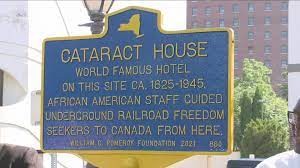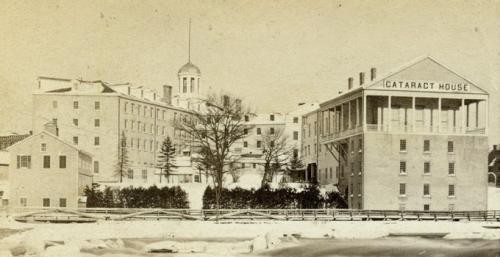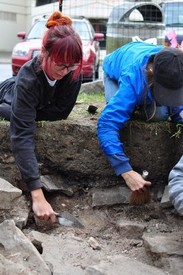Historic Marker at the Site of the Cataract House (Underground Railroad)
Introduction
Text-to-speech Audio
Situated along the Niagara River, the Cataract House was a legendary hotel and restaurant for decades. It opened in 1825 and became a significant element of the Underground Railroad, with the restaurant’s staff—many of whom were escaped slaves themselves—often helping to ferry other fugitives across the river to Canada. The hotel also hosted some of the most well-known Americans of the nineteenth century, including Abraham Lincoln and Andrew Jackson. Unfortunately, the building was badly damaged by a fire in 1945 and was demolished the following year. The hotel was located at the site of what is now Heritage Park in Niagara Falls, and a historic marker recognizing the Cataract House was placed in the park, across the street from the Red Coach Inn.
Images
A historic marker recognizing the Cataract House

The Cataract House

Archaeological work at the site of the Cataract House

Backstory and Context
Text-to-speech Audio
In the early 1800s, much of the shoreline along the American side of the Niagara River was lined with small mills and factories which depended on the river to supply water power. By the 1820s, however, travel to the area was becoming more popular and increased tourism led to a need for more accommodations. One of the existing mills, which was built in 1816, was converted into the Cataract House, which opened in 1825. At the time, the Cataract House was used as an overflow space for the nearby Eagle House, a hotel owned by General Parkhurst Whitney. The building faced Main Street with its rear facing the Niagara River.
The Cataract became a popular destination itself and eventually Parkhurst added a four-story addition to the building, as well as a wing that faced the river. Guests at the property could be dropped off directly in front of the hotel by the Lewiston and Lockport railroad. Parkhurst made additional improvements to the hotel in the 1840s, including having running water pumped down from tanks on the hotel's upper floors. River water was diverted to the basement in order to operate the hotel's laundry. He also built a new addition of five stories, which included a dining room, a two-story kitchen. To make the hotel easily identifiable along the river, a cupola was added to the roof, making the property a visual landmark. In the 1850s, when Whitney's son and sons-in-law had taken over the operations of the property, a ballroom was added with piazzas overlooking the river.
The expansive hotel was regarded as one of the grandest in the United States and its restaurant's menu was highly regarded. The hotel welcomed some of the most well-known Americans of the nineteenth century, including Andrew Jackson, Ulysses Grant, King Edward VIII, King George V, and Abraham Lincoln.
But for all of the hotel's grandeur and fame, its historical significance has more to do with its secret guests. Its location along the Niagara River made the hotel an ideal place for escaped slaves to make the crossing to Canada and freedom. For a number of years in the antebellum period, the hotel was a station on the Underground Railroad. It had a wait staff that was largely (perhaps entirely) African American, and it is estimated that roughly 80 per cent of the wait staff were escaped slaves themselves. Though the Whitneys were not known to be abolitionists, they certainly must have been aware of the activities taking place at the hotel. There are several documented escapes through the Cataract House, including the escapes of Patrick Sneed, a waiter, and a woman named Cecilia Jane Reynolds, as well as a failed rescue attempt. Apparently waiters at the hotel helped to ferry runaway slaves across the river into Canada. John Morrison, the head waiter at the hotel, often ferried escaped slaves across the river himself.
The hotel's popularity reached a peak in the late 1800s through about 1920, a time when railroad travel was expanding greatly and allowing for people to travel more easily. By the 1920s and 1930s, however, the hotel was no longer the grand structure that it once had been. It was an aging beauty and the Great Depression, followed by World War II, caused a decline in tourism. The hotel was purchased in 1945 by a developer who hoped to restore the Cataract to its former glory, but later that year, a fire erupted and the building was almost totally destroyed. It was demolished the following year.
Today, the site that was once occupied by the Cataract is roughly the site of the small Heritage Park. Archaeological work at the site is ongoing and a historical marker was placed across the street from the Red Coach Inn in 2021. In 2022, a new restaurant called the Cataract House Restaurant and Academy opened in Buffalo. The new restaurant is an homage of sorts to the original Cataract House and serves a menu based on dishes served in its restaurant.
Sources
Site of the Cataract House , Niagara Falls Underground Railroad . Accessed May 1st 2022. https://www.niagarafallsundergroundrailroad.org/wp-content/uploads/2019/06/02-Site-of-the-Cataract-House.pdf.
Cataract House Historic Marker Unveiled , Niagara Gazette. August 5th 2021. Accessed May 1st 2022. https://www.niagara-gazette.com/news/local_news/cataract-house-historic-marker-unveiled/article_f09fbce8-e616-5d2f-b4a9-3db9a88b9d16.html
Cataract House Archaeological Project , The Archaeological Survey. Accessed May 1st 2022. https://archaeologicalsurvey.buffalo.edu/current-and-research-projects/cataract-house-archaeological-project/.
Cataract House New Restaurant Brings Niagara Falls Underground Railroad History to Life , Niagara Frontier Publications. February 9th 2022. Accessed May 1st 2022. https://www.wnypapers.com/news/article/current/2022/02/09/149709/cataract-house-new-restaurant-brings-niagara-falls-underground-railroad-history-to-life.
Hammill , Luke . Digging Deep , University at Buffalo . Accessed May 1st 2022. https://www.buffalo.edu/atbuffalo/article-page-fall-2018.host.html/content/shared/www/atbuffalo/articles/Fall-2018/features/digging-deep.detail.html.
